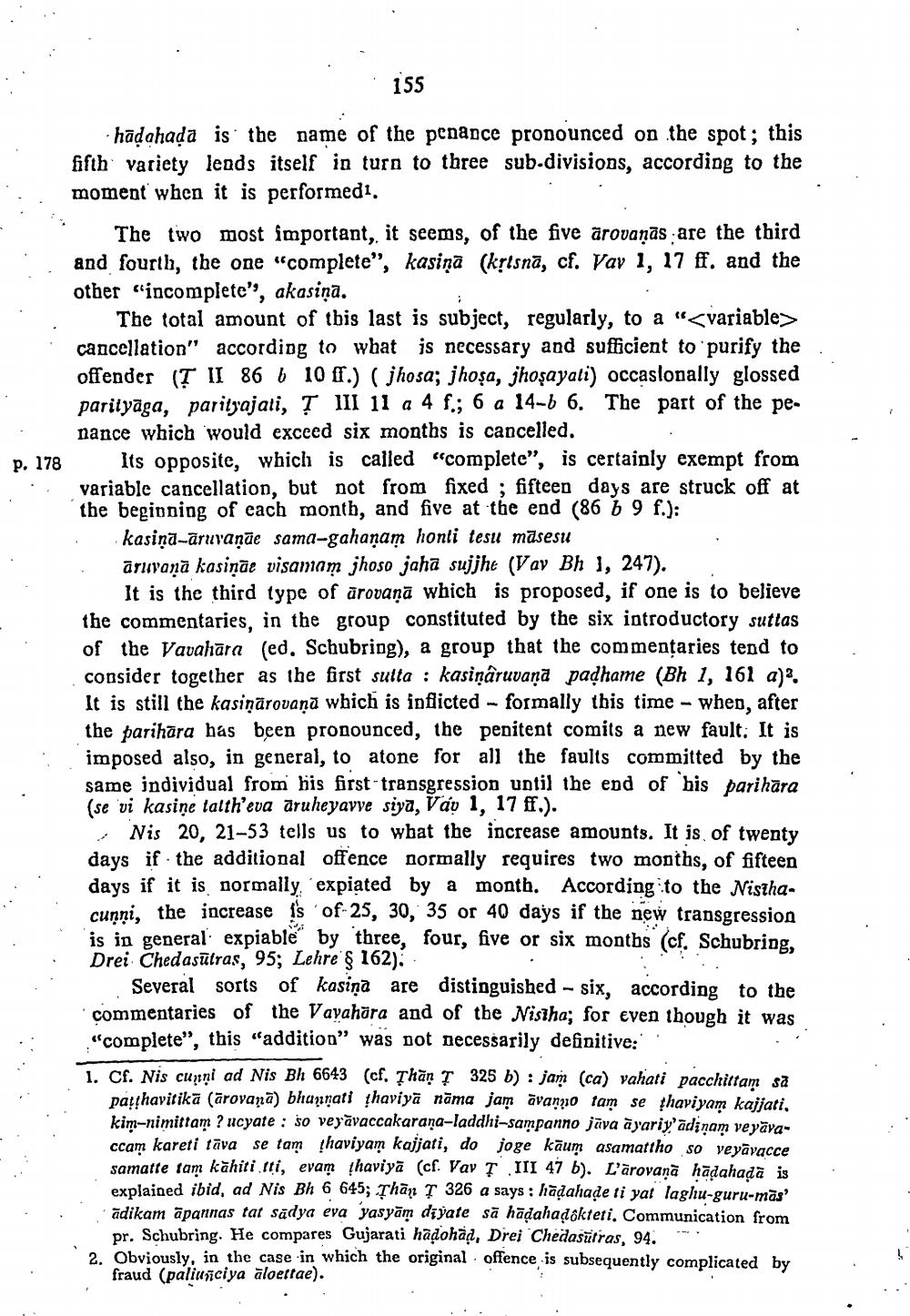________________
155
hādahada is the name of the penance pronounced on the spot; this fifth variety leads itself in turn to three sub-divisions, according to the moment when it is performedi.
The two most important, it seems, of the five ärovaņās are the third and fourth, the one "complete", kasiņā (krisnā, cf. Vav 1, 17 ff. and the other "incomplete", akasiņa.
The total amount of tbis last is subject, regularly, to a “<variable> cancellation” according to what is necessary and sufficient to purify the offender (T II 86 10 ff.) ( jhosa; jhoşa, jhoșayali) occaslonally glossed parityāga, parityajati, Ţ III 11 a 4 f.; 6 a 14–6 6. The part of the pe
nance which would exceed six months is cancelled. p. 178 Its opposite, which is called “complete", is certainly exempt from
ncellation, but not from fixed ; fifteen days are struck off at the beginning of each month, and five at the end (86 b 9 f.): : kasiņā-āruraņāe sama-gahaņam honti tesu māsesu
āruvanā kasiņāe visamiam jhoso jaha sujjhe (Vay Bh 1, 247).
It is the third type of ārovaņā which is proposed, if one is to believe the commentaries, in the group constituted by the six introductory suttas of the Vavahāra (ed. Schubring), a group that the commentaries tend to consider together as the first sulta: kasinaruvana padhame (Bh 1, 161 a). It is still the kasinārovanā which is inflicted - formally this time - when, after the parihara has been pronounced, the penitent comits a new fault. It is imposed also, in general, to atone for all the faults committed by the same individual from his first transgression until the end of his parihara (se vi kasine talth'eva druheyavve siya, Váy 1, 17 ff.).
Nis 20, 21-53 tells us to what the increase amounts. It is of twenty days if the additional offence normally requires two months, of fifteen days if it is normally, 'expiated by a month. According to the Nistha. cunni, the increase is of 25, 30, 35 or 40 days if the new transgression is in general expiable by three, four, five or six months (cf. Schubring, Drei Chedasūtras, 95; Lehre § 162).
Several sorts of kasina are distinguished - six, according to the commentaries of the Vavahöra and of the Nisiha; for even though it was "complete", this "addition” was not necessarily definitive: 1. Cf. Nis cunni ad Nis Bh 6643 (cf. Țhăn Ț 325 b) : jam (ca) vahati pacchittam sa
patchavitikā (ārovanā) bhannati thaviyā nāma jam āvanno tam se thaviyam kajiati. kim-nimittam ? ucyate : so veyāvaccakarana-laddhi-sampanno jāva a yariyadinam veyāvaccam kareti tāva se tam haviyam kajjati, do joge kāum asamattho so veyāvacce samatte tam kāhitinti, evam haviyā (cf. Vav T III 47 b). L'arovanā hādahada is explained ibid, ad Nis Bh 6 645; Țhān ? 326 a says: hādahade ti yat laghu-guru-mas' ādikam āpannas tat sadya eva yasyām dijate să hādahadokteti. Communication from
pr. Schubring. He compares Gujarati hādohad, Drei Chedasūtras. 94. - 2. Obviously, in the case in which the original offence is subsequently complicated by
fraud (paliunciya aloettae).
(cf. That nama ja sampanno




